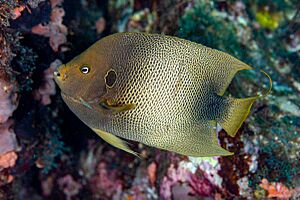Guinean angelfish facts for kids
Quick facts for kids Guinean angelfish |
|
|---|---|
 |
|
| Conservation status | |
| Scientific classification |
The Holacanthus africanus, also known as the Guinean angelfish or West African angelfish, is a beautiful fish that lives in the ocean. It's a type of marine angelfish found in the warmer parts of the eastern Atlantic Ocean, near the coast of West Africa.
Contents
What Does the Guinean Angelfish Look Like?
Young Guinean angelfish look very different from adults. When they are young, their bodies are a dark blue color. They have thin, light blue stripes near their eyes. Their tail fin is yellow, and they have yellow lips. A wide white stripe runs down the middle of their sides.
As they grow up, their blue color changes to an olive green. The white stripe on their sides gets wider and turns more yellowish. The area near their tail, called the caudal peduncle, becomes almost black. They might keep some yellow on the edges of their top fin (the dorsal fin) and bottom fin (the anal fin). They also have a dark spot that looks like an eye, called an ocellus, behind their gill cover (operculum). This fish can grow up to 45 centimetres (18 in) long.
Where Does the Guinean Angelfish Live?
The Guinean angelfish lives along the coast of West Africa. You can find it from Senegal all the way to the Congo River estuary. It also lives around the Cape Verde and São Tomé islands. In 2017, this fish was seen for the first time in the Mediterranean Sea, near Valletta harbor in Malta.
What Does the Guinean Angelfish Eat?
This angelfish likes clear water and lives around rocky reefs. It can be found at depths between 1 and 40 metres (3 and 131 ft). The Guinean angelfish isn't picky about its food. It mostly eats sponges. But it also enjoys eating tunicates, jellyfish, soft corals, algae, and tiny ocean creatures called plankton. Around the Cape Verde islands, these fish often swim in large groups with other types of fish. The Guinean angelfish is usually the most common fish in these groups.
Who Discovered the Guinean Angelfish?
The Guinean angelfish was first officially described in 1951. A French scientist named Jean Cadenat (1908–1992) gave it its scientific name. He was an ichthyologist, which is a scientist who studies fish. He found the first example of this fish in Gorée, Senegal.
Can You Keep a Guinean Angelfish as a Pet?
Yes, the Guinean angelfish can be found in the aquarium trade. However, it's quite rare to find them for sale. Only a few are available each year, and they can be very expensive. More of them started to become available in the late 2010s.


